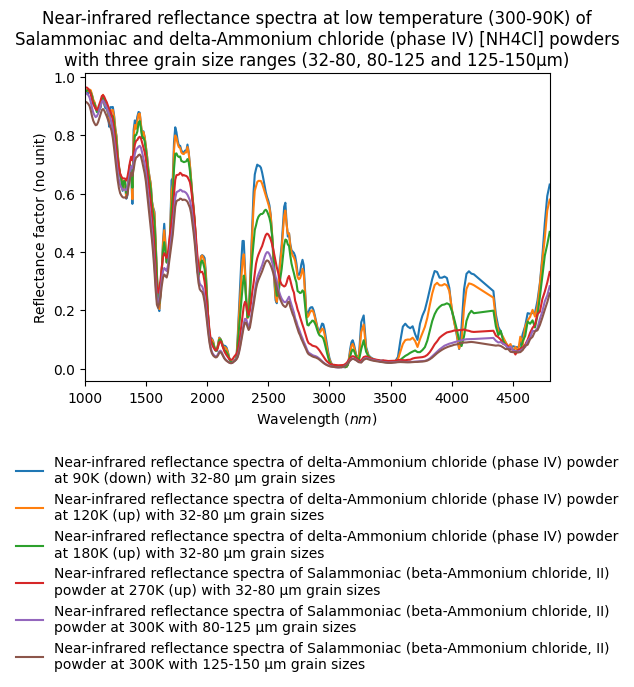- Title
- Near-infrared reflectance spectra at low temperature (300-90K) of Salammoniac and delta-Ammonium chloride (phase IV) [NH4Cl] powders with three grain size ranges (32-80, 80-125 and 125-150µm)
- DOI
- 10.26302/SSHADE/EXPERIMENT_BS_20201114_012
- Data reference
- Fastelli, Maximiliano; Comodi, Paola; Schmitt, Bernard; Beck, Pierre; Poch, Olivier (2020): Near-infrared reflectance spectra at low temperature (300-90K) of Salammoniac and delta-Ammonium chloride (phase IV) [NH4Cl] powders with three grain size ranges (32-80, 80-125 and 125-150µm). SSHADE/CSS (OSUG Data Center). Dataset/Spectral Data. https://doi.org/10.26302/SSHADE/EXPERIMENT_BS_20201114_012
- Publications
- Comments
- Europlanet-2024 TNA data - unpublished yet
- Database(s)
- Experimentalists
- Type(s)
- laboratory measurement
- Description
- Near-infrared reflectance spectra at low temperature of Salammoniac (beta-Ammonium chloride, phase II) (290-243K) and delta-Ammonium chloride (phase IV) (242-90K) powder [NH4Cl] with 32-80 µm grain size and Salammoniac powder at room temperature with 80-125µm and 125-150µm grain sizes
- Number of spectra
- 31
- Variable type(s)
-
- sample grain size
- sample phase
- temperature
- Comments
- change from Salammoniac (phase II) above 242K to delta-Ammonium chloride (phase IV) below
- Instrument
- SHINE Spectro-Gonio bidirectional reflection Vis-NIR
- Sample holder
- Cylindrical aluminum sample holder placed in the isothermal CarboN-IR cryogenic cell with two saphire windows. For the measurements at room temperature the two windows are removed.
- Standard medium
- vacuum
- Observation mode
- spectrum
- Spectral range type(s)
- NIR
- Valid spectral range(s)
-
Min - Max () Sampling () Resolution () Position accuracy () Absorption edge #1 1000.0 - 1600.0 10.0 7.7 1.0 #2 1610.0 - 2830.0 10.0 15.5 1.5 #3 2840.0 - 3200.0 10.0 30.0 3.0 #4 3220.0 - 4180.0 20.0 30.0 3.0 #5 4340.0 - 4800.0 20.0 30.0 3.0 - Comments
- A series of high pass filters is used to remove high orders of the gratings
Definition: incidence and emergence angles are positive with origin at nadir, and vary in same direction. Azimuth origin (increasing clockwise) is for i = e (opposition geometry).
- Observation geometry
- bidirectional
- Observation mode
- fixed angles
- Incidence angle
- 0.0°
- Emergence angle
- 20.0°
- Azimuth angle
- 0.0°
- Phase angle
- 20.0°
- Resolution illumination
- 5.8°
- Resolution observation
- 4.1°
- Comments
- 'Gognito' illumination attachment with focused beam.
Illumination
Observation
- Comments
- Partial polarization variable with wavelength (from the 3 monochromator gratings used)
- Observation mode
- single spot
- Spatial resolution
- 7.5
- Date begin - end
- 2020-11-10 - 2020-11-19
Versions
- Release date
- 2022-04-23 08:19:38+0000 UTC
- Version (Date)
- #1 (2022-04-23 08:19:38+0000 UTC, Updated: 2022-04-23 08:19:38+0000 UTC)
- Sponsors
-
- European Commission - Horizon 2020-RI (EC-H2020) (EPN2024-RI: Europlanet 2020 Research Infrastructure, grant No 871149 (TA2/DPSF/CSS/20-EPN1-016))
